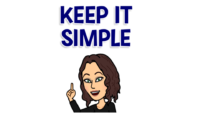
As many educators are transitioning from full time distance learning to a hybrid model, it is important that we maintain the momentum we have gained in implementing new technologies. Across the globe, billions of dollars have been spent on technology infrastructure, hardware, software, and professional training. In returning to physical classrooms, we don’t want these purchases to go to waste. However, this does not mean that it is the time to add yet another framework and/or additional expectations to educators’ already full plates of responsibilities. The key to sustainable implementation of effective technology integration lies in its simplicity, its ease of use, and proper context – an organic approach.
As an edtech coach, I am thrilled to see the incredible growth that educators in my midst have made in utilizing new technologies in distance learning. This is evidenced by the differences in the coaching I am asked to provide and the conversations I have with educators. Focus has shifted from logistics of how to utilize tools (set up safety for video calls, organize a class within an LMS, etc.) to ideas for using technology to empower students to create, to own their learning, to engage with academic content.
This is an exciting shift, one that I have been awaiting for years. There is a temptation to continue to push educators to the next level – to introduce even more new technology strategies, frameworks, and apps. But in my experience, I have learned that less is often more, and consistency is far more valuable than shiny new tech tools used every so often. It is vital that we maintain focus on what is most important – the students themselves. Active engagement in content. Leading with learning, never with tech. But what does this look like?
4 Cs Lesson Design
If we want to utilize technology in a way that empowers students, that focuses on learning rather than instruction, we must actively engage learners with content. The 4 C’s (communication, collaboration, critical thinking, creativity) lead to student activity – they focus on HOW students are engaging with academic content.
In considering ways to integrate technology into a lesson, start with the following questions:
How might students communicate about their learning?
How might students collaborate to build their understanding of learning?
How might students engage in critical thinking about their learning?
How might students express learning in a creative way?
Notice that the questions do not mention technology strategies, apps, or tools. Rather, they focus on how students actively engage in learning. It is the myriad answers to the questions where technology fits in – organically. The technology does not lead the lesson, it enhances the experience – it empowers students to engage in academic content in ways that may or may not have been able to be done without the technology. 4 C’s lesson design is simple, it allows for professional autonomy, and it focuses on student engagement. Beware of introducing a complicated framework or rigid checklist as educators are experiencing the aftereffects of a global pandemic that altered the state of their entire industry. We can maintain momentum and keep our focus on student learning with 4 C’s lesson design.

